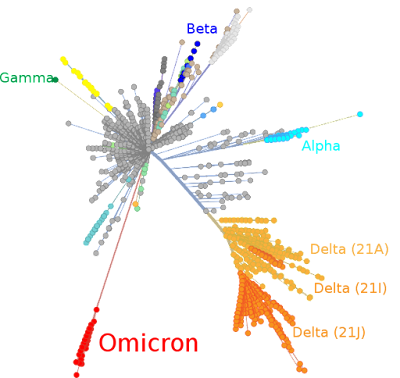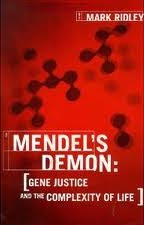"Bij het lezen van artikelen over Turing-patronen ging het licht aan. Als je
twee of meer stoffen in een vloeistof oplost en ze zijn egaal verdeeld, dan
verwacht je niet dat die stoffen na verloop van tijd zich vanzelf van elkaar
scheiden, zodat er patronen ontstaan, zoals strepen, vlekken, spiralen en
takvormige structuren. En dat is precies wat er gebeurt bij zelforganisatie." (Rolie Barth, 2021, De Kosmos en het leven, een Meesterwerk, pagina
500).
Dit citaat uit de Epiloog van het boek
De Kosmos en het leven, een Meesterwerk geeft precies aan waarom Rolie
Barth gefascineerd is door het werk van
Alan Turing. Regelmatige patronen kunnen niet spontaan ontstaan het niets, want dat is
strijdig met de Tweede Wet van de Thermodynamica. Toch lijkt zo iets ook in de biologie te gebeuren. De Britse wiskundige Alan Turing publiceerde
in 1952 een wiskundig model om patroonvorming in de biologie te verklaren.
Denk aan de strepen van de zebra (zie: omslag boek!). Zijn model veronderstelde 2 hypothetische stoffen, 'morfogenen', die zich ongelijk verspreiden door een uniform medium. Door interactie van die stoffen ontstaan vlekken of streeppatronen. Is zo'n relatief simpel mechanisme het geheim van patroonvorming uit het niets? Je kunt het een uitvinding noemen of een ontdekking. In die tijd en vele decennia daarna wist niemand of die morfogenen echt bestonden. Dat is een voordeel en een nadeel. Het voordeel is dat je naar hartenlust kunt experimenteren met wiskundige modellen. Het nadeel is dat die modellen je niet helpen bij het vinden van de morfogenen in concrete dieren. Met de kennis van nu kun je zeggen dat het Turing model baanbrekend was. Achteraf gezien was Turing een pionier.

|
Darae Jeong et al (2017)
bron
|
Bovenstaande zebra's zijn geproduceerd door een moderne drie-dimensionale variant van het Turing model.
De onderste rij is te vinden in het boek van Barth (pagina 200). De vorm van de zebra is als gegeven ingevoerd in het model, de strepen zijn door de computer ingevuld. Als je goed kijkt naar de strepen op echte zebra's, dan zie je dat die
computer gegenereerde zebra's niet goed lijken op echte zebra's. De overeenkomst is oppervlakkig.
De computer zebra's hebben geen staarten. En de staarten moeten een streepjes patroon tonen (zie foto hieronder). Ook de
voorkant, de achterkant, bovenkant en onderkant ontbreken in de computer zebra's. De strepen op de kop houden geen rekening met de ogen, want in het model zitten geen ogen. De buik van een echte zebra is wit. Ik vraag me af of die modellen ook 3D zijn in de zin dat je ze op je scherm kunt manipuleren en van alle kanten kunt bekijken? Daar zou ik graag eens mee willen spelen!

|
gestreepte zebrastaarten (bron)
|

|
baby zebra is gedeeltelijk bruin (bron)
|
De computer simulaties zijn kleurloos. Een baby zebra is
gedeeltelijk bruin. Dat introduceert een extra variabele en maakt de
simulatie complexer. Vooral als je alle fases van de patronen van baby naar
jong naar volwassene in 1 model wilt vatten.

|
uniek zebrajong met witte vlekken (bron)
|
 |
let op: wel strepen op de poten!
|
Een zeldzaam zebrajong met witte vlekken op een bruine achtergrond! [1]. Het verrassende is dat
computersimulaties met andere waardes voor de variabelen ook vlekken laten
zien! (zie de eerste 2 rijen in de figuur van Jeong hierboven). Dat is interessant en vraagt
om nader genetisch onderzoek (DNA onderzoek!).
 |
'Quagga' uit het terugkweek project (wikipedia)
|
Het lukt natuurlijk nooit om de door de mens uitgeroeide Quagga weer tot leven te brengen, maar de selectie experimenten uitgaande van onvolledig gestreepte individuen van de Common zebra zijn wetenschappelijk interessant omdat ze ons kostbare informatie kunnen geven over de genetica van de strepen. Er bestaat kennelijk genetische variatie waarop je kunt selecteren. Ik vraag me af of de mensen die bezig zijn met dit project beseffen dat ze aan het experimenteren zijn met de genetica van Turing patronen!
Terug naar het boek van Rolie Barth. Barth geeft de indruk dat alle biologen die zich
bezighouden met patroonvorming, Turing modellen gebruiken.
Maar dat is niet zo. Turing modellen werken met hypothetische morfogenen en en die modellen kunnen je niet helpen de chemische stoffen te identificeren die als morfogenen functioneren. Vergelijk: ook de 'genen' van Mendel waren puur hypothetisch. Om die morfogenen te vinden is
jarenlang grootschalig genetisch onderzoek nodig. De ontdekking van de
verantwoordelijk genen zijn hoogtepunten voor een onderzoeksgroep. Een belangrijk voorbeeld van dat hard werken is Christiane Nüsslein-Volhard die op grote schaal ontwikkelingsmutanten heeft gescreend. Uiteindelijk vond ze zo'n 120 genen die betrokken waren bij de vroege ontwikkeling van Drosophila. Het vakgebied dat ze mede heeft ontwikkeld heet ontwikkelingsgenetica. Voor haar werk ontving ze de Nobelprijs. In haar boek Coming To Life. How Genes Drive Development (2006) (de titel is veelzeggend!) wordt Turing niet genoemd. Wel noemt ze morfogenen en sommige diagrammen suggereren gradiënten. In haar recentere Animal Beauty. On the evolution of biological aesthetics wordt Turing als pionier erkend.
Hoe indrukwekkend Turing modellen ook zijn, ze helpen niet om de morfogenen te vinden in een concreet dier of plant. Bovendien zijn niet alle patronen in dieren met Turing modellen of
varianten daarvan te verklaren. Dit wordt beschreven door Ian Stewart in zijn
boek Life's other secret. Voorbeeld: het fruitvliegje Drosophila maakt strepen op een
geheel andere manier. Latere modellen combineren Turing logica met het aan/uit schakelen van genen. Brian Goodwin heeft nog een ander soort model ontwikkeld. Een zeer succesvolle theorie is Lewis Wolpert's theorie van 'positionele informatie'.
Evo-devo bioloog Sean Carroll is beroemd geworden door de ontdekking van genen die de patronen op vlindervleugels veroorzaken. Zijn onderzoek verscheen in het toptijdschrift Science met een foto van een vlindervleugel op de omslag. In zijn Endless Forms Most Beautiful (2005) schreef hij dat geen enkel Turing model van toepassing bleek op de resultaten van decennia lang evo-devo onderzoek. De werkelijkheid is veel complexer en was niet te voorspellen. Tevens beschrijft Carroll de publicatie van Jonathan Bard over de strepen van 3 soorten zebra's: (A) de Common zebra, (B) Mountain zebra en (C) Grevy's
zebra (p.240) [2]. Deze soorten verschillen duidelijk in het aantal strepen. Bard stelt dat het aantal strepen verklaard wordt door de verschillende tijdstippen in de ontwikkeling van het embryo dat melanocyten beginnen met migreren. (zie figuur hieronder).

|
3 soorten zebra's (Bard, 1977)
links: embryo
|
Wanneer de aanleg tot strepen ontstaan op dag 21 worden ze later bij het volwassen dier breder en zijn er minder. Als de aanleg op dag 35 ontstaat komen er meer strepen en zijn ze smaller. Omdat de afstanden in een volwassen dier te groot zijn voor diffuse van morfogenen werkt het Turing model hier niet.
Wiskundige modellen en genetisch-embryologisch onderzoek vullen elkaar aan. Een wiskundige model kan niet voorspellen welke genen betrokken zijn bij een biologisch proces. En op basis van genen alleen kun je niet voorspellen hoe het dier er uit gaat zien. Ook een combinatie van die twee kan niet berekenen hoe een bevruchte eicel zich tot volwassen dier ontwikkelt. Nog niet. Nog lang niet!
Het laatste woord is aan Rolie Barth:
"Onze wiskundige modellen zijn krachtige instrumenten om iets van het leven te verklaren, en tegelijkertijd zijn het ‘maar’ modellen, ontoereikend om de complexiteit van het leven in kaart te brengen. Daarnaast ben ik ook verwonderd over de denkkracht van Alan Turing die bijna zeventig jaar geleden een model ontwikkelde waarvan pas in de laatste decennia duidelijk wordt hoe groot de reikwijdte daarvan is. Zijn werk en dat van vele anderen heeft iets aan het licht gebracht over de ontwikkeling van die ene bevruchte eicel tot een compleet mens of dier." (Hoofdstuk 15: Leven - Structuurvorming en Zelforganisatie, p.280)
Bronnen
Rolie Barth (2021) De Kosmos en het leven, een Meesterwerk.
Alan Turing (1952)
The Chemical Basis of Morphogenesis (wikipedia)
Ian Stewart (1998) in zijn
Life's other secret. The new mathematics of the living world. pagina
142-150.
Brian Goodwin (1994) How the Leopard Changed Its Spots.
Sean Carroll (2005) Endless Forms Most Beautiful : "While the math and models are beautiful, none of this theory has been borne out by the discoveries of the last twenty years." (p. 123).
Christiane Nüsslein-Volhard (2006) Coming To Life. How Genes Drive Development. hardback 166 pagina's. Een mooi geïllustreerd populair-wetenschappelijk boek.
Christiane Nüsslein-Volhard (2019) Animal Beauty. On the evolution of biological aesthetics, pagina 71. Een klein boekje met artistieke illustratie's.
A baby black zebra geeft foto's van nog een andere donkere baby zebra.
Jonathan B . L. Bard (1977) A unity underlying the different zebra striping patterns, J . Zool., Lond. (1977) 183, 527-539
Noten
- Het donkergekleurde zebra jong vertoont witte vlekken op een donkere achtergrond. Dit kan betekenen dat witte vlekken ontstaan door inhibitie van melanine productie. Kan een Turing model ons vertellen of een zebra zwart is met witte strepen of wit met zwarte strepen?
- Dit zijn echte soorten, geen ondersoorten. Ze hebben een verschillend aantal chromosomen (bron) dus ze zijn miljoenen jaren geleden afgesplitst. Common zebra: 44; Mountain zebra: 32; Grevy's zebra: 46 chromosomen.























